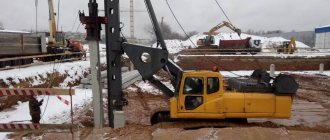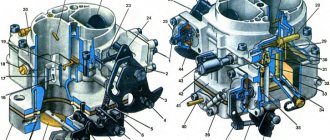The use of autonomous units for generating electricity is justified from both economic and practical points of view. However, for people living far from civilization, it is quite expensive and troublesome to purchase and transport natural gas or liquid fuel to their homes. In such a situation, a wood-burning gas generator comes to the rescue. Let's look at what this equipment is, how it is designed and on what principle it works, what types it is divided into, what its pros and cons are, and the rules for installing modern models.
Checking the operation of a wood-burning gas generator Source ytimg.com
Wood gas generator - what is it, device, principle of operation, application
In autonomous installations for generating electricity for the needs of a private home, an internal combustion engine is used. It can operate on gasoline, diesel fuel or natural gas. However, when it comes to remote areas, delivering such fuels will be economically unprofitable and technically difficult.
An alternative solution to this situation is a wood-burning gas generator. The motor of such a unit is powered by a mixture of gases - mainly hydrogen, carbon monoxide, methane and some other hydrocarbons. They are formed under special conditions during the thermal decomposition of wood, coal, peat, organic matter and other suitable types of solid fuel.
Device
A classic domestic wood-burning gas generator installation consists of the following main components:
- Frame . It is made of steel and can have a cylindrical or rectangular shape. Installed on special legs.
Diagram of a wood-burning gas generator Source gengas.lagunof.com
- Loading department . It is located and secured inside the housing. Designed for loading fuel through a special hatch, the edges of which are equipped with a special fire-resistant seal.
- The combustion chamber . It is heat resistant and is located at the bottom of the loading section. It directly burns fuel. To carry out thermal decomposition of resins, a special neck is equipped in its lower part. In the middle of the chamber there are special lance openings connected to an air supply device. The latter is equipped with a check valve to prevent the escape of flammable gases.
- Fan . If it is necessary to increase efficiency, as well as improve the combustion of certain types of fuel or very damp wood, the air distribution module is additionally equipped with a fan or turbine for increased air supply to the firebox.
- Grate bars . Installed at the bottom of the combustion chamber. Their main purpose is to support hot burning coals and separate the burnt substance - shedding ash into a special ash pan located below.
Gas generator installed on a car Source hsto.org
- Hatches . Special hermetically sealed lids - the top one for loading fuel with a device for equalizing pressure inside, the side one for loading into the recovery zone and the bottom one for removing slag.
- Gas pipeline . A pipe for removing the resulting mixture of gases from the combustion chamber. Due to the high initial temperature and the need for cooling for further use, it is specially carried out along a ring-shaped path in the cavity between the installation body and the loading chamber. This allows not only to cool the gas, but also to pre-dry the fuel before it enters the firebox.
- Filtration system . After leaving the chamber, the gas requires mandatory cleaning from soot and other suspended solids. Therefore, it is first fed hot into a coarse filter, and then, when cooled, it is subjected to finer filtration.
Upon completion, the purified and cooled gas mixture is fed into the mixing unit. Here the gas is saturated with oxygen to the required degree. Only after this is it supplied to the internal combustion engine.
An example of a household wood-burning gas generator Source ytimg.com
See also: Catalog of companies that specialize in electrical work of any complexity
Mechanism of action
The operating principle of a wood-burning gas generator boils down to the fact that under conditions of elevated temperature (about 1200-1500°C) and low oxygen levels, the wood does not burn as usual, but smolders, releasing generator gas, which serves as fuel for the internal combustion engine. The mechanism of operation of the installation is reduced to the following step-by-step processes occurring in the corresponding zones of the generator:
- Drying fuel . At a temperature of about 160-190°C, the firewood located in the uppermost part of the loading section is dried under the influence of gases passing through a ring pipeline.
- Dry distillation . In the middle part of the unit, where the heating level reaches 450-500°C, the wood is charred. As a result, in addition to coke, tars, acids and other products of low-temperature decomposition of fuel are formed.
- Burning . In the lowest part of the installation, at a maximum temperature of 1100-1500°C, charred fuel and decomposition products burn to carbon dioxide and carbon monoxide.
Reverse gas generator design Source uazbuka.ru
- Recovery . Carbon dioxide formed and heated in the lower part rises to hot coke and interacts with carbon and water, resulting in the formation of carbon monoxide and hydrogen.
In the combustion and recovery zone, not only combustible gases are formed, but also ballast gases. The former include carbon monoxide, hydrogen, methane and some unsaturated hydrocarbons, the latter – carbon dioxide, nitrogen, oxygen and water vapor. In addition, raw flue gas contains many inclusions in the form of slag, ash, and organic acids. Therefore, before putting it into the internal combustion engine, it must be thoroughly cleaned. For this purpose, coarse and fine filters are used.
Application
With high quality fuel, well-established technology and forced air supply, wood-burning gas generators achieve such high efficiency that they are even installed on cars. However, in most cases, their main area of application is objects and houses with an abundance of wood and difficult access to other types of energy resources (electricity, gas, gasoline, fuel oil, etc.).
Gas generator near the house Source ytimg.com
Wood generators are used in the following cases:
- For electrification of houses in remote areas without access to power grids.
- To ensure uninterrupted supply of electricity at facilities of high importance - military, scientific, medical bases.
- In industry - as an alternative source of electricity generation in the presence of associated production waste - wood chips, sawdust, scraps of building materials, etc.
Note! For stable and high-performance operation, the generator requires initially loading well-dried fuel. Thus, the use of raw firewood reduces efficiency by 25%. In addition, when raw wood smoulders, refractory resins are formed, which quickly clog the pipeline system, which will already lead to a decrease in the efficiency of the unit and will require frequent cleaning.
Classification
All gas generators can be divided into several categories, depending on the tasks assigned to them:
- By duration of work. The generator can operate as a permanent source of energy, as well as be operated temporarily. For example, on a construction site, where he will work 6-8 hours a day. The most common option is emergency use. The device is kept in the house or on site in case of a power outage.
- By power. This qualification most often corresponds to the location where the device is used. For small houses and cottages, devices up to 9 kW are chosen. For large private houses, cottages or small shops (workshops) - from 9 to 15 kW. More than 15 kW - for the needs of shops, small industries or workshops with constantly running equipment. Over 100 kW - for construction sites, large industries and farms.
- By the number of phases of the generated electric current. Everything is standard here, just like in gasoline or diesel generators, there are devices for one or three phases.
- By type of cooling. With passive cooling - a regular radiator with fins to dissipate heat, or active cooling - a fan with forced air flow to the radiator.
- By launch type. With automatic start from an electric starter. Or manual start, by pulling out a special starter handle.
- According to the version. Here you can highlight mobile generators. These are devices that can be carried by a person from place to place. This also includes larger devices on wheels. Large and heavy devices are installed permanently. They are assembled on a special metal frame. There is another group - stationary generators with a protective casing. These are devices on a metal frame, which are covered with metal on the top and sides.
- In terms of noise level. Here you can rely on direct values in dB. The generator usually makes a lot of noise. The lower the decibel rating, the less noise the device produces.
- According to the degree of protection. The protection class is indicated by two numbers. It usually looks like: “IP **”. The first digit in "**" indicates the level of protection. In this case: “0” is a lack of protection, “5” is security at the highest level. It is believed that IP 23 class is sufficient for domestic needs.
Some of the designations for the protection class, noise and power of the device can be found on the device’s nameplate or in the user manual.
Combined devices can be distinguished as a separate subgroup. They can run on both gas and gasoline.
Advantages and disadvantages
A gas generator machine for the production of flue gas, operating on wood, is characterized by the following number of advantages:
- High efficiency. Under accompanying conditions, the value can reach 95%.
- Up to 25 hours of burning per load of firewood.
Large sawdust gas generator for electricity generation Source d-system.ru
Price overview
| Model | power, kWt | Generator type | Types of gas | Gas consumption (100% load) | price, rub. |
| SPECIAL SG-2500 | 2 | Spare | Liquefied, natural | 0.8 m3/h | 22 000 |
| REG GG7200-A | 5,5 | Spare | Liquefied, natural, biogas | 2.2 m3/h | 51 200 |
| Greengear GE-6000 | 6 | Spare | Liquefied (propane) | 1.41 g/h | 75 500 |
| REG DK0008M | 8,8 | Spare | Liquefied, natural | 2.64 m3/h | 161 000 |
| Briggs & Stratton G60 | 6 | Spare | Liquefied, natural | 3.4 m3/h | 179 990 |
| Briggs & Stratton G110 | 10 | Spare | Liquefied, natural | 5.44 m3/h | 339 990 |
| FAS-28-3/VT TURBO | 28 | Primary, backup | Liquefied, natural | 9.5 m3/h | 635 000 |
| REG G12-1-RE-LS | 11 | Primary, backup | Liquefied, natural | 4.4 m3/h | 650 000 |
| REG G36-3-RE-LF | 26 | Primary, backup | Liquefied, natural | 9.9 m3/h | 1 130 000 |
| REG G58-3-RE-LF | 42 | Primary, backup | Liquefied, natural | 16 m3/h | 1 500 000 |
Installation Rules
When installing gas generating units using wood, it is recommended to follow the following rules:
- Installation of equipment is allowed anywhere in the house - basement, basement, room - as well as outdoors, subject to safety precautions and technical conditions.
- Models designed for loading long firewood are best installed outdoors near the fuel storage area.
- For installation inside the house, it is better to choose a generator that runs on pellets. Since their storage and operation does not involve the generation of waste.
- In the case of using flue gases for heating and minimal cooling, pipes to the house from a unit installed on the street are laid in thermal insulation and underground.
Recommendation! Gas generators exhibit maximum performance when fully loaded. However, the amount of energy generated can be excessive. Therefore, in order to preserve it, for example, for heating, it is necessary to use special heat-insulated containers - heat accumulators.
Calculation of the required generator power depending on the size of the powered building
In this matter, it is more correct to consider power not from the volume of the room, but from the consumers who are in it. For example, for winter living in a small house with 2 radiators of 1.5 kW (each) and standard household appliances, you will need a generator of 5 kW. For a house with 5 radiators and a large number of appliances - from 10 kW.
Calculating power is easy. You need to add up the power consumption from all electrical appliances in the house. Then add another 25% to the resulting value. This will be the required power of the gas generator. An additional 25% is taken on the basis that the device should not operate at peak loads for a long time.
Consider seasonality. If the generator is used only in the summer, when there is an emergency power outage, you can take a low-power device to provide basic needs.
Briefly about the main thing
Modern models of wood-burning gas generators are so effective that they can even be installed on a car. However, in most cases, it is a successful way to save on fuel for remote areas where, apart from firewood, there are no other types of energy resources, and delivering them there is unprofitable. Simplified, the unit consists of a housing, a loading chamber, a firebox and an ash pan. Its operating principle is based on the thermal decomposition of wood or coal at low oxygen levels, and subsequent reduction to carbon monoxide and hydrogen.
Flue gases are cooled, purified and mixed with oxygen before entering the internal combustion engine. The main advantages of gas generators of this type:
- Great efficiency.
- Up to 25 hours of burning per load.
- Complete burning of wood.
- Power adjustment.
- No harmful emissions.
- Economical.
- Possibility of using raw wood.
- Operation on other types of fuel.
- Safety.
- Large chamber volumes.
The disadvantages are manifested in the high cost, energy dependence of modern models, the possibility of clogging, gas temperature control, manual loading, and the need to use dry fuel. In this case, there are 3 varieties - direct, reverse and horizontal. Each of them has its own pros, cons and application features. The installation of the unit must be carried out in accordance with the regulations.
Advantages of a gas generator
- Long operating time : the device is active as long as there is gas in the main pipe. Additionally, by installing natural gas cylinders in a parallel system, you can increase its operating time. This advantage of a gas generator is the main one, in contrast to an inverter device that runs on gasoline or diesel fuel. Its operation will end when the entire fuel supply in the tank is used up.
- The cost of a cubic meter of gas is less than any other fuel. It can be stored in cylinders or other closed containers for a long time, which cannot be said about other types of fuel.
- The service life is much longer than that of other types of fuel. This is explained by the fact that the cylinders and piston system of such a device wear out little. This occurs due to the fact that very few combustion products are formed at the outlet. Metal corrosion is also minimal.
- Eco-friendly . There are no emissions of harmful substances, soot and all kinds of emissions.
My choice
In the class of budget generators, I advise you to take a closer look at machines from Russian Engineering Group ; they are distinguished by their low price and inappropriately high quality. In particular, GG7200-A and SH3000 produce a smooth sine wave and are equipped with a non-Chinese motor. As a stationary generator, I highlight the Briggs&Stratton 8 kW Standby for its reliable design, good output parameters of voltage (215-225V), frequency (49-51 Hz).
Rating of TOP 10 best models
| Place | Name | Price |
| TOP 10 best gas generators | ||
| 1 | Generac 6520 | 170 000 ₽ |
| 2 | Russian Engineering Group GG7200-A | 70 000 ₽ |
| 3 | BRIGGS & STRATTON 6 kW Standby Generator | 179 000 ₽ |
| 4 | Russian Engineering Group GG8000-A | 75 000 ₽ |
| 5 | Generac 7144 | 315 000 ₽ |
| 6 | GVB 6000 MG | 85 000 ₽ |
| 7 | Generac RG 027 3P | 1 140 000 ₽ |
| 8 | Comfort GAZ-4.5kW-ES | 40 000 ₽ |
| 9 | Greengear GE-5000 | 48 000 ₽ |
| 10 | Grandvolt GVB 13500 T ES G | 230 000 ₽ |











